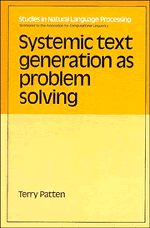Book contents
- Frontmatter
- Contents
- Dedication
- Preface
- 1 Introduction
- 2 Background I: AI problem solving
- 3 Background II: systemic grammar
- 4 The conflation
- 5 The formal model
- 6 The implementation
- 7 Related work in text generation
- 8 Conclusions
- Appendix A OPS5 tutorial
- Appendix B Sample texts
- Appendix C Excerpts from the grammar
- Notes
- Bibliography
- Index
2 - Background I: AI problem solving
Published online by Cambridge University Press: 26 March 2010
- Frontmatter
- Contents
- Dedication
- Preface
- 1 Introduction
- 2 Background I: AI problem solving
- 3 Background II: systemic grammar
- 4 The conflation
- 5 The formal model
- 6 The implementation
- 7 Related work in text generation
- 8 Conclusions
- Appendix A OPS5 tutorial
- Appendix B Sample texts
- Appendix C Excerpts from the grammar
- Notes
- Bibliography
- Index
Summary
This chapter is intended to provide the background required to understand the AI aspects of the text-generation method presented in Chapter 4. This introduction will not be a comprehensive survey, but rather a primer to specific concepts and perspectives relevant to the generation method. First, the architecture of AI problem solving will be outlined. Second, the search-space model will be introduced and some search methods will be examined. Third, the idea of knowledge compilation will be explored, emphasizing the key role played by compiled knowledge in AI problem solving.
The architecture of AI problem solving
This discussion of the architecture of AI problem solving will have several limitations and biases–it will address AI problem solving as it is manifested in practical AI projects (especially expert systems), and it will be strongly biased toward the architecture and representations adopted in Chapter 6.
While the architecture of AI problem solving corresponds to some degree to the computer-science architecture–a program processing data–(see Brownston et al., 1985, p. 56), this correspondence is more likely to be misleading than helpful here. The architecture of AI problem solving involves three major components–the knowledge base, the inference engine, and the data memory or working memory. It must be assumed that any given problem solver will have been constructed to operate in some specific problem area or domain. Information about the classification of domain objects, the properties associated with these classes, the operations that can be performed within the domain, and other invariant domain-specific knowledge is stored in the knowledge base.
- Type
- Chapter
- Information
- Systemic Text Generation as Problem Solving , pp. 6 - 18Publisher: Cambridge University PressPrint publication year: 1988



